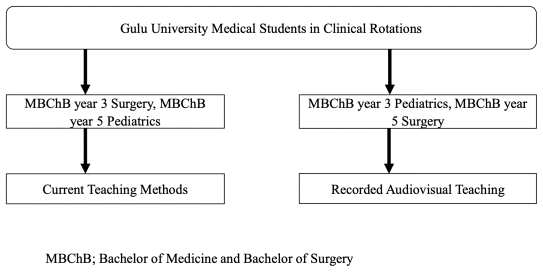
Figure 1 Allocation based on possible rotation among the medical students
Pebalo Francis Pebolo1, Felix Bongomin2, Silvia Awor3, Baifa Arwinyo4, Sande Ojara5, Jimmyy Opee6, Ayikoru Jackline7, Jerom Okot8, Eric Ssennuni9, Simple Ouma10, and Annettee Nakimuli11
1MMed, Dr, Lecturer, Obstetrics and Gynaecology, Gulu University, Gulu, Uganda
2MMed, Dr, Lecturer, Microbiology and Immunology, Gulu University, Gulu, Uganda
3PhD, Dr, Lecturer, Obstetrics and Gynaecology, Gulu University, Gulu, Uganda
4MMed, Dr, Consultant, Obstetrics and Gynaecology, Gulu Regional Referral Hospital, Gulu, Uganda
5Dr, Lecturer, Obstetrics and Gynaecology, Gulu University, Gulu, Uganda
6MMed, Dr, Lecturer, Obstetrics and Gynaecology, Gulu University, Gulu, Uganda
7BSc Midwifery, Simulation Assistant, Obstetrics and Gynaecology, Gulu University, Gulu, Uganda
8Medical Student, Faculty of Medicine, Gulu University, Gulu, Uganda
9MBChB, Dr, Medical Officer, Faculty of Medicine, Gulu University, Gulu, Uganda
10MPH, Dr, Research Department, Lecturer, The Aids Support Organisation, Kampala Uganda
11PhD, Dean, Professor of Obstetrics and Gynaecology, School of Medicine, College of Health Sciences, Makerere University, Kampala, Uganda
Abstract
Background: Postpartum intrauterine device (PPIUD) is a highly effective long-term contraceptive method inserted after delivery. In Uganda, low uptake is linked to a lack of insertion skill training among providers, hindering teaching efforts for pre-service trainees. Video-based training, beneficial in high-resource areas, faces limitations in low-resource settings due to device access challenges. We aimed to evaluate the preliminary effectiveness of audio-visual content in teaching PPIUD knowledge and insertion skills to undergraduate medical students in Uganda. Methods: A two-arm, quasi-experimental design was used in which the experimental group received pre-recorded lectures and skills sessions, and the control group received current teaching methods. Paired and independent t-tests assessed differences in knowledge and skills acquisition within and between groups using Stata version 17 and GraphPad Prism version 9. Results: The analysis of 67 students (37 control, 30 intervention) showed significant post-test score improvement in both groups (p<0.001). Although the intervention group had a higher mean post-test score than the control group, the difference wasn’t significant (p=0.069). Some student categories, like pre-test failures (p=0.021) and MBChB year 3 students (p=0.011), performed better with audio-visual aids. No significant difference was found in procedure performance scores between the intervention and control groups (p=0.634). Discussion: Audio-visual contents positively impacted medical students’ knowledge and skills, suggesting a role in reproductive health training in Ugandan settings.
Key Words: audio-visual, pedagogy, clinical, medical education, procedures, intrauterine device, Uganda
Date submitted: 7-June-2024
Email: Pebalo Pebolo (pebalopebolo@gmail.com)
This is an open access journal, and articles are distributed under the terms of the Creative Commons Attribution-Non Commercial-Share Alike 4.0 License, which allows others to remix, tweak, and build upon the work non-commercially, as long as appropriate credit is given and the new creations are licensed under the identical terms.
Citation: Pebolo P, Bongomin F, Awor S, Arwinyo B, Ojara S, Opee J, Jackline A, Okot J, Ssennuni E, Ouma S, and Nakimuli A. Effectiveness of pre-recorded presentation of postpartum intrauterine device insertion training for medical students in Uganda. Educ Health 2024;38:14-25
Online access: www.educationforhealthjournal.org
DOI: 10.62694/efh.2025.109
Published by The Network: Towards Unity for Health
Postpartum intrauterine device (PPIUD) is an effective long-acting contraceptive method that is normally provided immediately after delivery.1,2 PPIUDs have been shown to reduce unintended pregnancies and maternal mortality, making them a crucial component of reproductive health services.3 Despite its reported effectiveness, the low uptake of PPIUD (1.1–1.5%) in Uganda,4 results from the healthcare providers’ skills gap,5,6 limiting in-service and pre-service training in the country.
In many medical schools in resource-limited settings, Uganda inclusive, medical students experience difficulties obtaining instruction for procedural skills due to fewer faculties and an increasing number of students. This was worse during the COVID-19 pandemic when semesters were shortened to catch up the time lost and fewer students were allowed for social distancing requirements.7 Such an epidemic is expected to re-occur in the future, and therefore there is a need to have methods of instruction suitable for a social distancing context. The use of Information and Communication Technology (ICT) is advancing in producing, distributing, and accessing educational content,8 including within clinical environments,9 is expected to solve this.
Information and Communication Technology that uses the traditional didactic pedagogy for virtual lectures is typically in a broadcast mode, making no room for individual learners to manage their cognitive load.10 Recordable ICT with replay options such as audio-visual content positively affects student learning by appealing to different learning styles11 and helping students to visualize things that may not be illustrated.12,13 It enhances students’ memory, comprehension, active learning, motivation, and control of the learning process and caters for individual differences14 and it is key in the implementation of other advanced teaching methods such as the flipped classroom (FC).
Despite the high knowledge of ICT among medical learners, the utilization is low in low-resource settings due to poor or lack of internet connectivity, related costs and negative attitudes towards the learning methods,15 inadequate resources, and lack of skilled professionals.16 Audio-visual content can help bridge the gaps in procedural learning in already crowded clerkship placement.17
In most medical education institutions18 as well as in Uganda, didactic lectures remain the primary method of instruction. This is supplemented by case-based, group-based student-led tutorials, and portfolio-based learning for knowledge transfer. Clinical and procedural skills teaching is done through bedside learning and side-room procedures. Skills-based or case-based simulation using mannequins or other teaching methods supplement the skills teaching including teaching of PPIUD insertion expertise. The effectiveness of audio-visual recording in enhancing all these learning methods, especially for teaching PPIUD insertion in undergraduate medical education, remains unknown. We aimed to evaluate the preliminary effectiveness of the audio-visual content compared to the traditional teaching methods in teaching PPIUD knowledge and insertion skills to undergraduate medical students in Uganda.
This was a two-arm, before-and-after, quasi-experimental study.
The research was carried out at the Faculty of Medicine, Gulu University, a public university situated in Northern Uganda, approximately 350km north of Kampala, the capital of Uganda. The study focused on medical students in their clinical rotation, specifically those in Bachelor of Medicine and Bachelor of Surgery (MBChB) year 3 and year 5 (MBChB 3 and 5). The university offers two tracks for admission to the MBChB program: the direct entry scheme, which competitively admits students directly from advanced-level schools without prior medical training; and the diploma/mature-age entry scheme, which competitively admits students with prior health professional training. Year 3 and year 5 medical students rotate in four major clinical departments: Reproductive Health (Obstetrics and Gynecology), General Surgery, Pediatrics and Child Health, and Internal Medicine. Each student is expected to rotate in a specific department for seven weeks in an academic year. The rotating students are divided into two rotation lots: Pediatrics/Surgery and Reproductive Health/Internal Medicine. Notably, PPIUD training is not included in the Gulu University MBChB curriculum, making this study an opportune occasion to evaluate the use of recorded audio-visual teaching in knowledge and psychomotor skills transfer without adding time pressure on students.
Four rotations were possible for block allocation: MBChB 3 Pediatrics, MBChB 3 Surgery, MBChB 5 Pediatrics, and MBChB 5 Surgery. The MBChB 3 Surgery and MBChB 5 Pediatric rotations were conveniently assigned to the current teaching methods (control) group, while the MBChB 3 Pediatric and MBChB 5 Surgery rotations were assigned to the recorded audio-visual teaching (intervention) group (see Figure 1). The first two trainings were for the control group, and the last two were for the intervention group. This was done to minimize contamination in case participants in the control group accessed the recorded materials. As the study was conducted in the Department of Reproductive Health, students rotating in the department during the data collection period were excluded from the study due to the potential influence of their presence in the department on their decisions to participate.

Figure 1 Allocation based on possible rotation among the medical students
All participants were invited via a flyer posted on their rotation’s WhatsApp group. Initially, the control group was informed of the study’s purpose, and those who accepted to take part provided written informed consent. Subsequently, each participant was allocated a unique group number based on clusters, as shown in Figure 1, and then pre-tested before the training commenced.
The recruitment process for participants in the intervention group was similar, except that a pre-test and a unique group identification number were given a week earlier before the training. Each participant was requested to provide an email address through which the audio-visual materials were shared.
The PPIUD course content encompassed a variety of topics related to the insertion of IUDs immediately after childbirth. It included fundamental knowledge about PPIUDs, such as the types of available IUDs, their efficacy rates, indications and contraindications for use, and potential side effects. Participants were also taught anatomical consideration of a postpartum uterus and counselling skills to facilitate discussions with patients about the benefits and risks of PPIUDs, enabling patients to make informed decisions. Infection prevention measures include hand hygiene, decontamination, high-level disinfection, and sterilization techniques.
The training materials were based on a manual developed for providers,19 and the lecture was delivered by the principal author—an experienced PPIUD trainer. Procedural demonstrations covered the steps involved in inserting the intrauterine device (IUD), including assessing uterine size, positioning the device, and ensuring adequate follow-up care. This was based on PPIUD insertion steps by the Centre for International Reproductive Health Training (CIRHT)20. The PPIUD training was conducted over weekends to avoid interfering with normal academic activities in the faculty.
The teaching and demonstration of PPIUD in the control group typically involved 1-hour didactic lectures to cover the PPIUD course content. On-site demonstrations of PPIUD insertion were conducted using Mama U trainers, which are anatomical models simulating the female reproductive system immediately after childbirth. The demonstration was carried out by four midwives who are certified PPIUD trainers, based on Objective Structure Clinical Exams (OSCE) sample stations for contraception and abortion reference materials.20 Following the demonstration, students were allowed to practice the steps in groups of 10 participants under guidance for four hours before being assessed.
The intervention was a student accessing 32 minutes of PowerPoint voiceover and a 16-minute procedure steps audio-visual educational content a week before face-to-face trainings. The same course content used for the control group was utilized to create pre-class material for the intervention group. A 32-minute PowerPoint voiceover for knowledge teachings was produced by the principal author who is a national PPIUD trainer in Uganda. The 16-minute video for procedure steps for PPIUD insertion was produced by a simulation assistant who is a graduate midwife with over two years of experience in training PPIUD to undergraduate medical students, and it is based on PPIUD insertion steps by the Centre for International Reproductive Health Training (CIRHT)20.
After the preparation of each part of the audio-visual instructional methods, its contents were evaluated by all authors and faculty members, and adjustments were made. The materials were uploaded to a YouTube account and unlisted, with the link being shared a week prior to a planned face-to-face training. This unlisted link allowed restricted access only to those with the link. Participants were advised not to share the link with others and reminded three times via email to watch and attend the planned face-to-face training. During a planned 30-minute in-class knowledge transfer session, the topic’s objectives were discussed, followed by small group discussions and presentations of questions and answers. The recorded PPIUD procedure video steps were replayed on a large 75-inch interactive screen, and students were allowed to practice the procedures on Mama U anatomical models under the guidance of four trainers. The practice was conducted in groups of 10 participants for four hours before assessment. It’s important to note that even though producing video lectures can be costly and time-consuming, we managed to keep costs low by utilizing an established audio-visual production studio at the Department of Reproductive Health, Gulu University.
The contents for teaching and step-by-step audio-visual procedure as described earlier were used.20, 21 The four midwives involved in training underwent a 6-hour training to unify the steps in the demonstration and assessment. During this time, they were able to individually demonstrate the steps while being peer-assessed using the same tools, and any discrepancies were resolved. This was done in the presence of the principal investigator, an experienced PPIUD trainer. The midwives were paired into groups of two during assessments so that they could discuss and agree on the procedure assessments.
The pre-tests in each group were done immediately at the beginning of recruitment. Following a one-day intensive training based on their group assignment (current teaching method or recorded audio-visual), the participants underwent a post-test, which consisted of a multiple-choice questions (MCQs) knowledge test and a PPIUD procedural skills performance score using a structured checklist. The post-test questions were identical to those in the pre-test. This assessment tool was utilized for PPIUD pre-tests and post-test assessments in the Amhara region in Ethiopia21 and was found to be effective. The procedural skills assessments were observed by two paired midwives assessors who scored using the OSCE sample stations for contraception and abortion reference materials.20 The pre-tests, post-tests, and procedural assessment tools did not include students’ identification details, except for unique student allocation groups and numbers, as well as basic information regarding the students’ age and mode of university admission.
Paired t-tests were performed to determine the differences in knowledge acquisition in each group and independent samples t-tests were used to compare groups. Stata version 17 and GraphPad Prism version 9 were used for analysis in this study. The data was analyzed by a modified intention to treat basis.
Approval to conduct the study was obtained from the Gulu University Research and Ethics Committee (GUREC) #GUREC-2022-33. All participants provided written informed consent and were assured that this training and assessment would not contribute to their final marks or be included in their end-of-semester examination. Administrative clearance was obtained from the Office of the Dean, Faculty of Medicine, Gulu University.
A total of 82 medical students were invited to participate in the study; 40 were assigned to the control teaching method and 42 to the intervention teaching method. In the control group, three students declined the invitation. In the intervention group, five students declined the invitation, one did not register for the semester, four did not complete the training, and two forgot their unique identification number, and these were all excluded. The remaining 67 were included in the final analysis, 37 in the control and 30 in the intervention arm as seen in Figure 2.
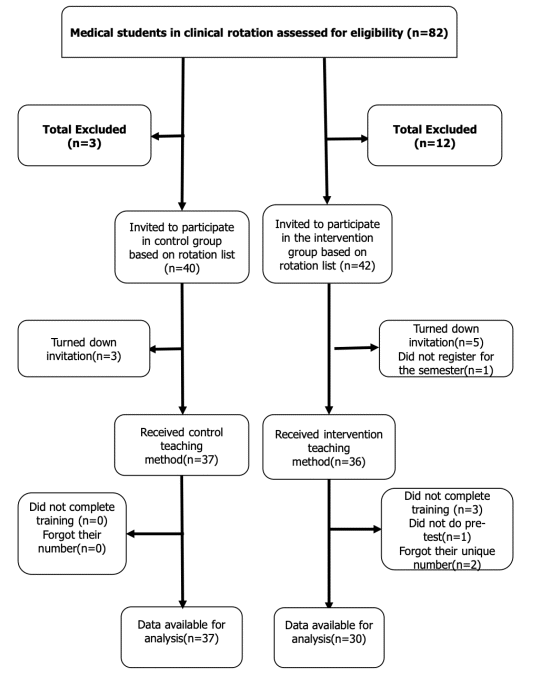
Figure 2 CONSORT flow diagram showing allocation of the participants
The mean age of the students was similar, 28.4 and 27.4 for the control and intervention groups respectively. A total of 33 MBChB 3 were included in the analysis, 19 (57.6%) in the control teaching method and 14 (42.4%) for the intervention teaching group. Of the 34 MBChB, five included in the final analysis, 28 (52.9%) were in the control group and 16 (47.1%) in the intervention group (Table 1). Of the 67 participants, 39 (58.2%) were admitted through direct entry while 41.8% were through a diploma/mature entry scheme. The direct entrants had 20 (51.3%) in the control group and 19 (48.7%) in the intervention group, meanwhile, for those under diploma/mature age entry, 17 (60.7%) were in the control group and 11 (39.3%) in the intervention group (Table 1).
Table 1 Baseline Characteristics of the Study Participants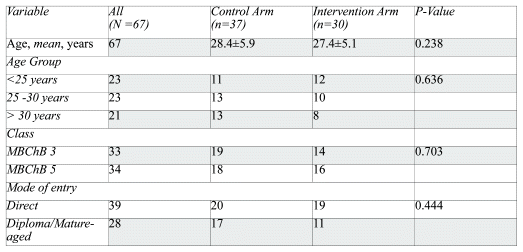
The mean pre-test scores were significantly higher among participants in the intervention group (58.83±% versus 53.38±%, p= 0.039). The mean pre-test for MBChB 3 was 47.1 and 54.6 for the control and intervention groups respectively. Similarly, MBChB 5 scored 60 and 62.5 on average and this is not statistically different (p= 0.257). Direct entrants had similar scores among the control and intervention groups; 53.4 vs 57.1 (Table 2).
Table 2 Paired sampled t-test comparing pre-test scores among the control and intervention groups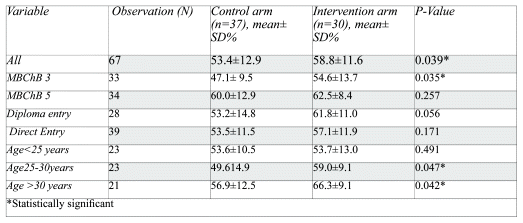
The mean post-test and pre-test scores were 78.5±9.2 and 53.4±12.9 for the control group (A) and 81.6±7.2 and 58.8±11.6 for the intervention group (B) respectively, and this was statistically significantly different p <0.001 (Figure 3).
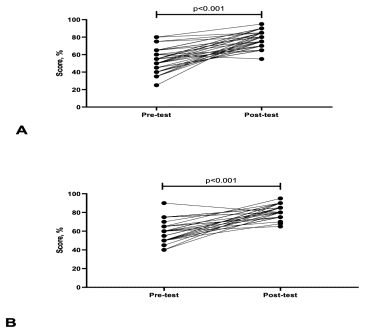
Figure 3 Before and after graph showing pre- and post-test scores of the participants; A Control group (N=37), B Intervention group (N=30)
The students who had the intervention had higher average post-test scores compared to the control, although, this was not a statistically significant difference, p=0.069. The post-test scores were higher for the intervention compared to the control group especially among those who failed pre-tests (85.0±5.0 Vs 75.0± 7.1, p=0.021), in MBChB 3 class (83.8±6.9 Vs 76.3± 9.8, p=0.011), direct entrant schemes (80.4±6.8 Vs 75.0±8.6 p=0.018) and aged younger than 25 years (82.3±5.5 Vs 71.4±6.6 p=0.002) as seen in Table 3 above. Although the mean post-test scores among mature/diploma entrants and those whose pre-test scores are between 50–70% were higher among the intervention group, it is not statistically significant p=0.2143 and 0.378 respectively. However, among those who scored more than 75% in the pre-tests, they performed better with the current teaching method p=0.8941. There were similar mean post-test scores among those in the year 5 class, aged 25–30 years and aged above 30 years old (Table 3).
Table 3 Comparison of post-test scores among the Control and Intervention groups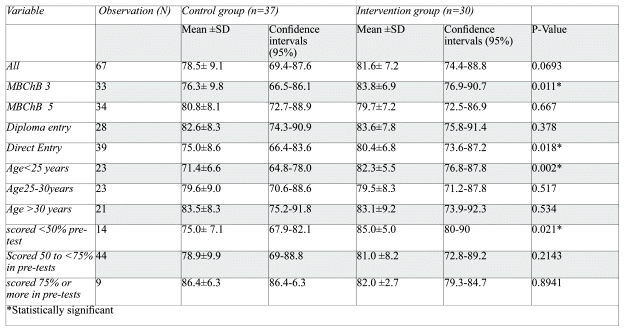
Overall, the mean procedure scores for the intervention group and the control were similar. Participants in year 5 and those who scored more than 75% in the pre-test had a better score in the intervention group compared to the control group although these were not statistically significant, p=0.146 and 0.243 respectively. The interrater agreement between assessor 1 and 2 was poor (4.48%) for the expected 5.10%, p=0.059.
Table 4 Comparison of mean PPIUD skills procedure score among the control and intervention
The objective of this study was to assess the initial effectiveness of the recorded audio-visual instruction (intervention) in comparison to the current (control) method of instruction among medical students in clinical rotation. The intervention was designed to make sure students get exposed to audio-visual content before class activities. The findings indicated a notable improvement in post-test scores as compared to pre-test scores in both the control and intervention groups. This suggests that the recorded audio-visual instruction is successful in imparting knowledge in PPIUD knowledge acquisition among undergraduate medical students in Uganda, which is similar to single-case research designs involving five participants who have been exposed to audio-visual contents had better scores compared to those on the standard teaching methods.22 Similarly, video-based lectures were shown to be effective compared to the current teaching methods in a randomized clinical trial involving 272 patients in teaching osteoporosis although with different participants and methodological consideration.23 This is an indication that video-based lectures and procedural steps could improve skills acquisition in other areas of reproductive health or clinical procedures. Additionally, audio-visual-based flipped classrooms were shown to be effective in knowledge transfers in studies conducted in other settings.24–26
While not statistically significant, the average post-test score among those who received the intervention was higher compared to those who received the current teaching method. This suggests that intervention was non-inferior compared to the current teaching methods in training PPIUD knowledge and insertion skills among medical students in Uganda. This finding is similar to a study that was done among physiology students in Alexandria University’s Faculty of Medicine in which students who had video-based lectures scored better compared to traditional print-based lectures.27
Additional analysis revealed that the advantages of intervention were more evident among specific groups of students, such as those who had failed the pre-tests. This could be attributed to the increased effort these students had to engage with the materials since the questions seemed difficult for them, resulting in their performances being comparable to those who initially had better knowledge. This finding is similar to a study that demonstrated improved post-test scores among low-achieving students after audio-visual FC compared to the current teaching method.28 Also, students who were MBChB 3 class performed better than the MBChB 5 contrary to a finding in which the more senior students performed better in audio-visual FC methods of instruction.29 Similarly, direct entrants and those aged younger than 25 years had higher post-test scores in the intervention group than in the control group. However, this may be because the direct entrants are also younger, bringing a collinearity. Despite all these, the study suggests that the audio-visual teaching methods may be particularly useful for these groups of students.
On the other hand, among those who scored more than 75% on the pre-tests, the current teaching methods were found to be more effective. This suggests that there may be a threshold beyond which the benefits of intervention may not be as pronounced. Additionally, the study found that there were no significant differences in post-test scores among students in the MBChB 5 class, those aged 25–30 years, and those aged above 30 years old.
Regarding procedural training, the procedure videos resulted in lower overall mean post-test scores compared to the current teaching methods. However, it did identify some potentially important trends of the intervention on PPIUD skills procedure scores, particularly among students in MBChB 5 and those who scored well on the pre-test. While these trends did not reach statistical significance, they suggest that the intervention is comparably effective with the current teaching method, and further research is warranted to explore its potential benefits in reproductive health education. This is contrary to a study done among students subjected to evaluating pediatric patients presented as video cases for clinical skills, students exposed to an audio-visual teaching program were seen to score higher.30
Audio-visual content helps students to manage their cognitive loads, by pausing and replaying recorded content on their own time improving the long-term retention of knowledge and skills.31 This is of interest with the access of these contents through smartphones into clinical environments,9 and enhanced group-based learning activities inside the classroom, wards, and clinics.
The poor interrater reliabilities should necessitate the use of video-assisted assessment tools for future reviews which have been a promising intervention in the assessment of students on clinical-based training,32 this can be an opportunity to provide more objective feedback to learners as they have the opportunity to review the recorded session.33
Overall, the study’s robust design and inclusion of a mechanism to lessen contaminations strengthened the credibility of the findings, enhancing confidence in the preliminary effectiveness of the intervention in undergraduate PPIUD training. Despite this precaution, the pre-test scores in the intervention group were higher than those of the current teaching methods, indicating potential contamination. While conducting a randomized trial in educational settings may present technical challenges, it could be beneficial in eliminating such contaminations. It is important to note that the study had a scope (PPIUD), which may not fully capture the potential effects or benefits of using audio-visual methods in undergraduate reproductive education. It is possible that the outcomes observed in this limited context may not be representative of the broader impact of audio-visual contents across various topics, student learning styles and preferences, and over a longer period of training. Another limitation is related to the fact that this study did not investigate the extent to which the knowledge and skills acquired through audio-visual content were retained by the students over time. This information would have provided valuable insights into the long-term impact of intervention on knowledge retention and its potential benefits for the students’ future clinical practice.
Despite these limitations, the findings of this study have important implications for reproductive health education as well as other clinical training. The audio-visual teaching methods can provide students with greater flexibility and accessibility to educational materials, which may be particularly important for students in low-income countries. Furthermore, audio-visual teaching methods may be an effective way to improve student performance, particularly among certain groups of students. However, it should be noted that the method may have some threshold beyond which it is not effective. Therefore, medical schools and educators should consider incorporating recorded audio-visual teaching methods into their curricula, while also considering the unique needs and learning styles of their students. Understanding the processes of how to integrate audio-visual material into medical curricula in low-resource settings is paramount. Additionally, future studies could investigate how different teaching methods can be combined to create a blended learning approach that maximizes the benefits of both the recorded audio-visual content and the current teaching method.
Funding: This research was funded with support from the Center for International Reproductive Health Training at the University of Michigan (CIRHT-UM). The funder had no role in the design of the study and collection, analysis, and interpretation of data and in writing the manuscript.
Acknowledgments: We would like to acknowledge the study participants in general and the Dean and Deputy Dean Faculty of Medicine at Gulu University for their support during this study.
We thank the Pre-Publication Support Service (PREPSS) for supporting the development of this manuscript by providing author training, as well as pre-publication peer-review and copy editing.
Author contributions: All authors made substantial contributions to the conception and design, acquisition of data, or analysis and interpretation of data; took part in drafting the article or revising it critically and approved the final version.
Consent for publication: Not applicable.
Conflict of interest statement
The authors declare that there is no conflict of interest.
The datasets used and/or analyzed during the current study are available from the corresponding author on reasonable request.
1. Thapa, K., Dhital, R., Karki, Y. B., Rajbhandari, S., Amatya, S., Pande, S., Tunnacliffe, E. A. (2018). Institutionalizing postpartum family planning and postpartum intrauterine device services in Nepal: Role of training and mentorship. International Journal of Gynecology Obstetrics, 143, 43–48. https://doi.org/10.1002/ijgo.12604
Crossref PubMed
2. Lopez, L. M., Bernholc, A., Chen, M., Grey, T. W., Otterness, C., Westhoff, C., ... Helmerhorst, F. M. (2016). Hormonal contraceptives for contraception in overweight or obese women. Cochrane Database of Systematic Reviews, (8). https://doi.org/10.1002/14651858.CD008452.pub4
Crossref
3. Eva, G., Gold, J., Makins, A., Bright, S., Dean, K., Tunnacliffe, E. A., ... Dalziel, K. (2021). Economic evaluation of provision of postpartum intrauterine device services in Bangladesh and Tanzania. Global Health: Science and Practice, 9(1), 107–122. https://doi.org/10.9745/GHSP-D-20-00447
PubMed PMC
4. UBoS, I. C. F. (2017). Uganda demographic and health survey 2016: key indicators report. Kampala, Uganda. Accessed online: https://www.ubos.org/wp-content/uploads/publications/03_2018Uganda_DHS_2016_KIR.pdf
5. Kanakuze, C. A., Kaye, D. K., Musabirema, P., Nkubito, P., Mbalinda, S. N. (2020). Factors associated with the uptake of immediate postpartum intrauterine contraceptive devices (PPIUCD) in Rwanda: a mixed methods study. BMC Pregnancy and Childbirth, 20, 1–11. https://doi.org/10.1186/s12884-020-03337-5
Crossref
6. Senderowicz, L., Pearson, E., Hackett, K., Huber-Krum, S., Francis, J. M., Ulenga, N., Bärnighausen, T. (2021). ‘I haven’t heard much about other methods’: quality of care and person-centredness in a programme to promote the postpartum intrauterine device in Tanzania. BMJ Global Health, 6(6), e005775. https://doi.org/10.1136/bmjgh-2021-005775
Crossref
7. Bongomin, F., Olum, R., Nakiyingi, L., Lalitha, R., Ssinabulya, I., Sekaggya-Wiltshire, C., ... Byakika-Kibwika, P. (2021). Internal medicine clerkship amidst COVID-19 pandemic: a cross-sectional study of the clinical learning experience of undergraduate medical students at Makerere University, Uganda. Advances in Medical Education and Practice, 253–262. https://www.tandfonline.com/doi/full/10.2147/AMEP.S300265#d1e327
Crossref PubMed PMC
8. Nicolaou, C., Matsiola, M., Kalliris, G. (2019). Technology-enhanced learning and teaching methodologies through audiovisual media. Education Sciences, 9(3), 196. https://doi.org/10.3390/educsci9030196
Crossref
9. Chase, T. J., Julius, A., Chandan, J. S., Powell, E., Hall, C. S., Phillips, B. L., ... Fernando, B. (2018). Mobile learning in medicine: an evaluation of attitudes and behaviours of medical students. BMC medical education, 18(1), 1–8. https://doi.org/10.1186/s12909-018-1264-5
Crossref
10. Merkt, M., Weigand, S., Heier, A., Schwan, S. (2011). Learning with videos vs. learning with print: The role of interactive features. Learning and Instruction, 21(6), 687–704. https://doi.org/10.1016/j.learninstruc.2011.03.004
11. Alawani, A., Senteni, A., Singh, A. D. (2016, October). An investigation about the usage and impact of digital video for learning. In Proceedings of the 15th European Conference on e-Learning: ECEL (pp. 1–9).
12. Preradovic, N. M., Lauc, T., Panev, I. (2020). The effect of medium of instruction on undergraduate student learning style in video-based learning. Int. J. Educ. Inf. Technol, 14, 1–7: 10.46300/9109.2020.14.1
Crossref
13. De Boer, J., Kommers, P. A., De Brock, B. (2011). Using learning styles and viewing styles in streaming video. Computers Education, 56(3), 727–735. https://doi.org/10.1016/j.compedu.2010.10.015
Crossref
14. Alessi, S. M., Trollip, S. R. (2000). Multimedia for learning: Methods and development. Allyn Bacon, Inc.. https://dl.acm.org/doi/abs/10.5555/557640
15. Olum, R., Atulinda, L., Kigozi, E., Nassozi, D. R., Mulekwa, A., Bongomin, F., Kiguli, S. (2020). Medical education and E-learning during COVID-19 pandemic: awareness, attitudes, preferences, and barriers among undergraduate medicine and nursing students at Makerere University, Uganda. Journal of Medical Education and Curricular Development, 7, 2382120520973212. https://doi.org/10.1177/2382120520973212
Crossref PubMed PMC
16. Frehywot, S., Vovides, Y., Talib, Z., Mikhail, N., Ross, H., Wohltjen, H., ... Scott, J. (2013). E-learning in medical education in resource constrained low-and middle-income countries. Human resources for health, 11, 1–15. DOI: https://doi.org/10.1186/1478-4491-11-4
Crossref
17. Kagawa, M. N., Kiguli, S., Steinberg, W. J., Jama, M. P. (2021). The workplace as a learning environment: Perceptions and experiences of undergraduate medical students at a contemporary medical training university in Uganda. African Journal of Health Professions Education, 13(2), 110–117. https://hdl.handle.net/10520/ejc-m_ajhpe_v13_n2_a5
Crossref
18. Niccum, B. A., Sarker, A., Wolf, S. J., Trowbridge, M. J. (2017). Innovation and entrepreneurship programs in US medical education: a landscape review and thematic analysis. Medical education online, 22(1), 1360722. https://doi.org/10.1080/10872981.2017.1360722
Crossref PubMed PMC
19. Fowler, R. C. (2010). Postpartum intrauterine contraceptive device (PPIUD) services: A reference manual for providers. USA. November. Accessed online: https://www.glowm.com/pdf/Global%20PPIUD%20Reference%20Manual.pdf
20. Beza, S. W. (2019). OSCE Sample Stations for Contraception and Abortion. Accessed: https://hdl.handle.net/2027.42/152423
21. Abebaw, Y., Berhe, S., Abebe, S. M., Adefris, M., Gebeyehu, A., Gure, T., ... G/Egziabher, M. A. (2019). Providers’ knowledge on postpartum intrauterine contraceptive device (PPIUCD) service provision in Amhara region public health facility, Ethiopia. PloS one, 14(4), e0214334. https://doi.org/10.1371/journal.pone.0214334
Crossref PMC
22. Nikopoulou-Smyrni, P., Nikopoulos, C. (2010). Evaluating the impact of video-based versus traditional lectures on student learning. http://bura.brunel.ac.uk/handle/2438/4652
23. Chotiyarnwong, P., Boonnasa, W., Chotiyarnwong, C., Unnanuntana, A. (2021). Video based learning versus traditional lecture-based learning for osteoporosis education: a randomized controlled trial. Aging clinical and experimental research, 33, 125–131. https://doi.org/10.1007/s40520-020-01514-2
Crossref
24. Angadi, N. B., Kavi, A., Shetty, K., Hashilkar, N. K. (2019). Effectiveness of flipped classroom as a teaching–learning method among undergraduate medical students–An interventional study. Journal of education and health promotion, 8(1), 211. https://doi.org/10.4103/jehp.jehp_163_19
Crossref
25. Gillispie, V. (2016). Using the flipped classroom to bridge the gap to generation Y. Ochsner Journal, 16(1), 32–36. Accessed: https://www.ochsnerjournal.org/content/ochjnl/16/1/32.full.pdf
PubMed PMC
26. Morgan, H., et al., The flipped classroom for medical students. The Clinical Teacher, 2015. 12(3): p. 155–1. https://doi.org/10.1111/tct.12328
Crossref PubMed
27. El-Sayed, R. E. H., El-Hoseiny, S., El-Sayed, E. (2013). Video-based lectures: An emerging paradigm for teaching human anatomy and physiology to student nurses. Alexandria Journal of medicine, 49(1), 215–222. https://doi.org/10.1016/j.ajme.2012.11.002
Crossref
28. Nouri, J. (2016). The flipped classroom: for active, effective and increased learning–especially for low achievers. International Journal of Educational Technology in Higher Education, 13, 1–10. https://doi.org/10.1186/s41239-016-0032-z
Crossref
29. Yin, H. (2020). Exploring the Effectiveness of a Flipped Classroom with Student Teaching. e-Journal of Business Education and Scholarship of Teaching, 14(1), 66–78. https://eric.ed.gov/?id=EJ1276429
30. Malon, M., Cortes, D., Greisen, G. O. (2014). Medical students’ assessment of pediatric patients-teaching and evaluation using video cases. BMC medical education, 14, 1–7. https://doi.org/10.1186/s12909-014-0241-x
Crossref
31. Persky, A. M., McLaughlin, J. E. (2017). The flipped classroom–from theory to practice in health professional education. American journal of pharmaceutical education, 81(6), 118. https://doi.org/10.5688/ajpe816118
Crossref
32. Duran, M., Hendrix, J. M. (2023). The Role of Videotaped Clinical Skills Aggregated Peer Evaluations in the Enhancement of Evaluation Skills of Individual Medical School Faculty Members. Cureus, 15(4). 10.7759/cureus.37871
Crossref
33. Ho, K., Yao, C., Novak Lauscher, H., Koehler, B. E., Shojania, K., Jamal, S., ... Eva, K. (2019). Remote assessment via video evaluation (RAVVE): a pilot study to trial video-enabled peer feedback on clinical performance. BMC Medical Education, 19, 1–9. https://doi.org/10.1186/s12909-019-1905-3
Crossref
© Education for Health.
Education for Health | Volume 38, No. 1, January-March 2025